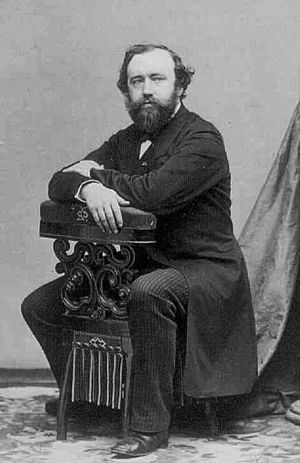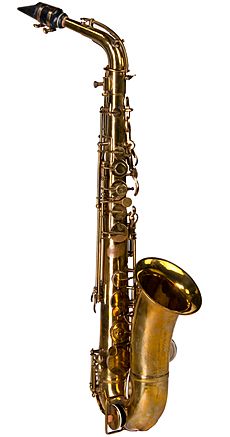Adolphe Sax facts for kids
Adolphe Sax (born Antoine-Joseph Sax; 6 November 1814 – 7 February 1894) was a talented Belgian inventor and musician. He is most famous for inventing the saxophone in the early 1840s. He received a patent for his invention in 1846.
Sax also created other musical instruments. These include the saxotromba, saxhorn, and saxtuba. He also improved the design of the bass clarinet, which is still used today. Adolphe Sax was a skilled musician himself, playing both the flute and the clarinet.
Contents
Early Life and Challenges
Growing Up in a Creative Family
Antoine-Joseph Sax was born on November 6, 1814, in Dinant, which is now part of Belgium. His parents were Charles-Joseph Sax and Marie-Joseph Masson. Even though his birth name was Antoine-Joseph, everyone called him Adolphe from a young age.
His parents were also instrument designers. They made important changes to the French horn. Adolphe started making his own instruments when he was very young. At just 15, he entered two of his flutes and a clarinet into a competition. Later, he studied music at the Royal Conservatory of Brussels. He learned to play the flute and clarinet, and also to sing.
A Childhood Full of Close Calls
Adolphe Sax had many accidents when he was a child. He once fell from a height of three floors and hit his head. People thought he had died. When he was three, he drank a bowl of acid, thinking it was milk. He also swallowed a pin.
He suffered serious burns from a gunpowder explosion. Another time, he fell onto a hot frying pan, burning his side. He also nearly got poisoned or suffocated several times. This happened when he slept in a room where varnished furniture was drying. Once, a cobblestone hit him on the head, and he fell into a river. He almost drowned.
His mother once said he was "a child condemned to misfortune." His neighbors even called him "little Sax, the ghost."
Career and Later Life as an Inventor
Inventing New Sounds
After leaving the Royal Conservatory, Sax began inventing new instruments. His parents continued their business of making traditional instruments. Sax's first big invention was an improved bass clarinet. He patented this design when he was 24 years old.
In 1842, he moved to Paris permanently. There, he started working on a new group of valved bugles. While he didn't invent the bugle, his versions were much better than others. These became known as saxhorns. The famous composer Hector Berlioz loved these instruments. In 1844, he even had a piece played entirely on saxhorns.
Saxhorns were made in seven different sizes. They helped lead to the creation of the flugelhorn. Today, saxhorns are sometimes used in concert bands, marching bands, and orchestras. They also helped develop the modern euphonium.
The Saxophone's Birth
Sax also created the saxotromba family of instruments in 1845. These were brass instruments with a narrower sound. However, they were not used for very long.
The saxhorn valves were considered very advanced at the time. They are still largely the same today. The improvements made by Adolphe Sax quickly influenced the British brass band movement. These bands started using only saxhorn instruments.
Around 1840, Sax invented an early design of the contrabass clarinet. On June 28, 1846, he patented the saxophone. He designed it for use in orchestras and military bands. By 1846, Sax had designed saxophones of many sizes. These ranged from very small (sopranino) to very large (subcontrabass).
Composer Hector Berlioz wrote positively about the saxophone in 1842. However, saxophones did not become a regular part of orchestras. But they could play fast like woodwinds and be loud like brass instruments. This made them perfect for military bands in France and other countries.
Challenges and Legacy
Sax's good reputation helped him get a teaching job. He started teaching at the Paris Conservatory in 1857. He continued to make instruments later in his life. He also led the new saxophone course at the Paris Conservatory.
Sax faced many legal problems over his patents. Rival instrument makers often challenged his inventions. He also sued others for using his ideas without permission. He went bankrupt three times during his life.
Between 1853 and 1858, Sax suffered from an illness. But he made a full recovery. In 1894, he died in Paris from pneumonia. He passed away in poverty. He was buried in section 5 at the Cimetière de Montmartre in Paris.
- Other invented instruments
Honors and Awards
- In his hometown of Dinant, Belgium, there is a museum called Mr Sax's House. It is dedicated to his life and his saxophones.
- 1849: He was given the Chevalier rank of the Legion of Honour. This is a very important French award.
- 1867: He won the First Grand Prize for Instrument Making at the 1867 Paris International Exposition.
- 1995: His picture was featured on the front of Belgium's 200 Belgian francs banknote.
- 2015: Google Doodle celebrated his 201st birthday with a special drawing.
See also
 In Spanish: Adolphe Sax para niños
In Spanish: Adolphe Sax para niños







